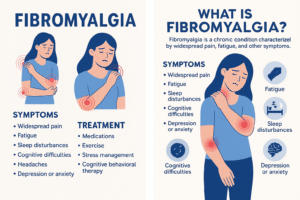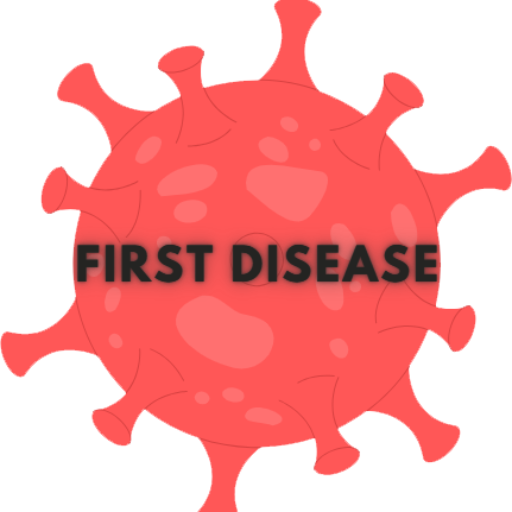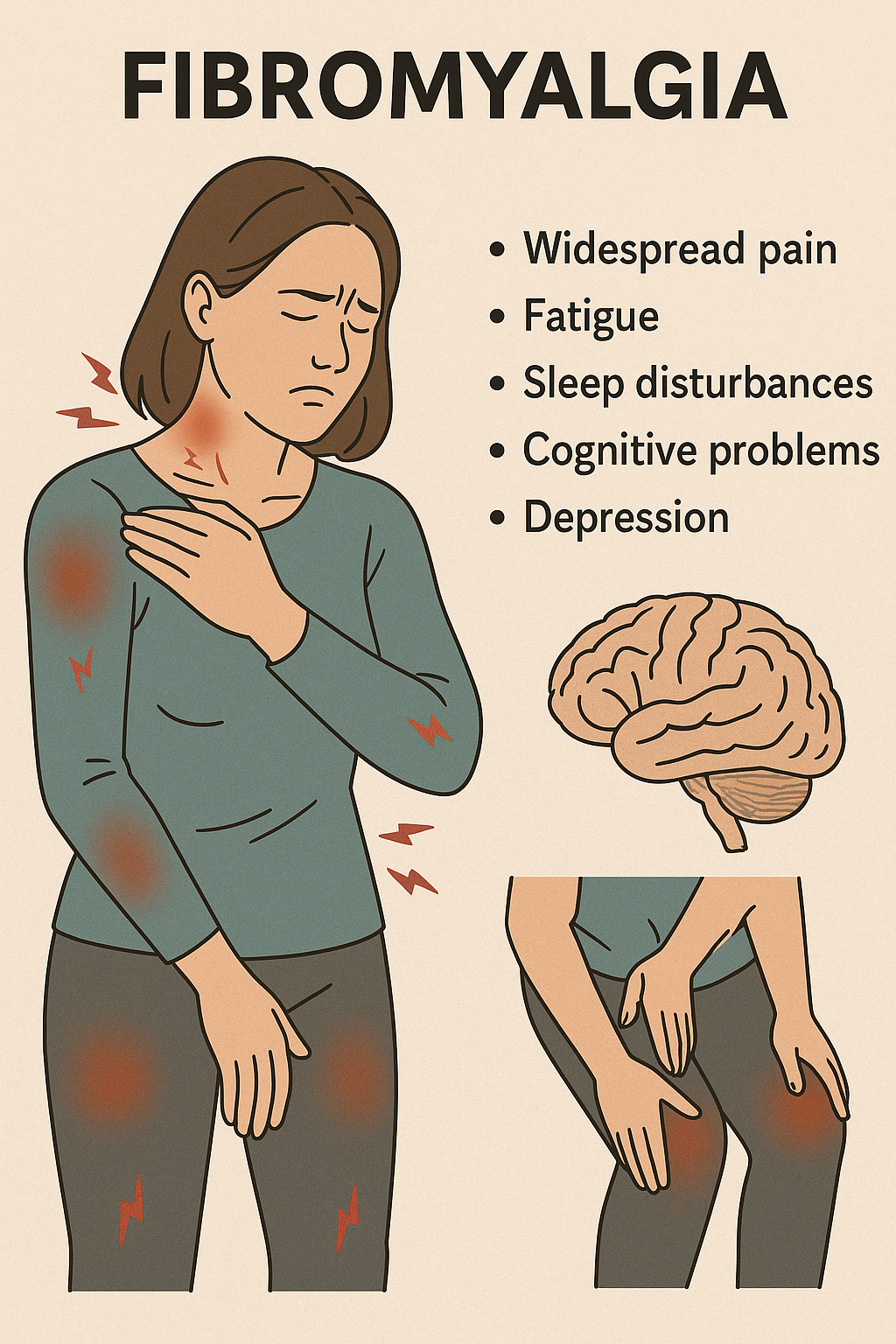🌸 Understanding Fibromyalgia: A Complex and Chronic Pain Disorder
1. What is Fibromyalgia?
Fibromyalgia is a long-term (chronic) disorder characterized by widespread musculoskeletal pain, fatigue, sleep disturbances, and cognitive difficulties. It affects how the brain and spinal cord process pain signals, often amplifying painful sensations. Although the exact cause is unknown, it is believed to involve a combination of genetic, environmental, and psychological factors.
It is more common in women than men and often appears during middle adulthood, though it can affect people of all ages.
2. Common Symptoms of Fibromyalgia
Fibromyalgia symptoms can vary in intensity and may fluctuate daily. The key symptoms include:
🧠 Widespread Pain
-
Persistent dull ache that lasts for at least three months
-
Pain occurs on both sides of the body and above and below the waist
🛌 Fatigue
-
Feeling tired even after a full night’s sleep
-
Trouble falling or staying asleep (non-restorative sleep)
-
May overlap with chronic fatigue syndrome
🧠 Cognitive Difficulties (“Fibro Fog”)
-
Problems with focus, attention, and memory
-
Slowed thinking or mental confusion
😖 Other Associated Symptoms
-
Headaches or migraines
-
Irritable bowel syndrome (IBS)
-
Tingling or numbness in hands and feet
-
Depression or anxiety
-
Sensitivity to noise, light, or temperature
3. What Causes Fibromyalgia?
The exact cause of fibromyalgia is unknown, but researchers believe it involves:
-
Abnormal pain perception: Changes in the way the brain processes pain signals
-
Neurochemical imbalances: Low levels of serotonin, dopamine, and norepinephrine
-
Genetics: Tends to run in families
-
Triggers: Physical trauma, surgery, infections, or significant psychological stress
4. Who Is at Risk?
Some factors that increase the likelihood of developing fibromyalgia include:
-
Gender: Women are far more likely to be diagnosed
-
Age: Most common between ages 30 and 60
-
Family history
-
Other disorders: Lupus, rheumatoid arthritis, or osteoarthritis
-
Chronic stress or trauma

5. How Is It Diagnosed?
There is no definitive test for fibromyalgia. Diagnosis is based on:
-
Medical history and symptom review
-
Physical examination
-
Widespread Pain Index (WPI) and Symptom Severity Scale (SSS)
-
Excluding other conditions (like hypothyroidism, lupus, or arthritis) through blood tests or imaging
A diagnosis is usually made when a patient has widespread pain for more than three months without another identifiable cause.
6. Treatment Options
Although there is no cure for fibromyalgia, a combination of treatments can help manage symptoms:
💊 Medications
-
Pain relievers (acetaminophen, NSAIDs)
-
Antidepressants (duloxetine, amitriptyline)
-
Anti-seizure drugs (pregabalin, gabapentin)
-
Sleep aids
🧘 Therapies
-
Cognitive Behavioral Therapy (CBT): Helps manage negative thoughts and stress
-
Physical therapy: Improves flexibility and strength
-
Occupational therapy: Helps with adapting to daily activities
🧘♀️ Lifestyle Approaches
-
Regular low-impact exercise (walking, swimming, yoga)
-
Balanced diet
-
Sleep hygiene (consistent sleep schedule, calming bedtime routines)
-
Stress management techniques (meditation, mindfulness, deep breathing)

7. Living with Fibromyalgia
Managing fibromyalgia requires a holistic approach. Support from family, healthcare providers, and support groups can make a big difference. Patients are encouraged to:
-
Track symptoms to identify triggers
-
Set realistic goals and pace themselves
-
Celebrate small achievements
-
Seek psychological support when needed
8. Is Fibromyalgia a Disability?
While fibromyalgia is not always visible, it can significantly impact a person’s ability to work or perform daily activities. In many countries, it is recognized as a legitimate disability, and patients may be eligible for social or financial support depending on their symptoms and work limitations.
9. Conclusion
Fibromyalgia is a complex and often misunderstood condition. While there is no cure, many people find effective ways to manage their symptoms and improve quality of life. Increased awareness, early diagnosis, and an individualized care plan are key to living well with fibromyalgia.
Don’t forget to check our page for similar and different diseases or treatments.
What Causes Transmissible Spongiform Encephalopathy and How to Treat It?







